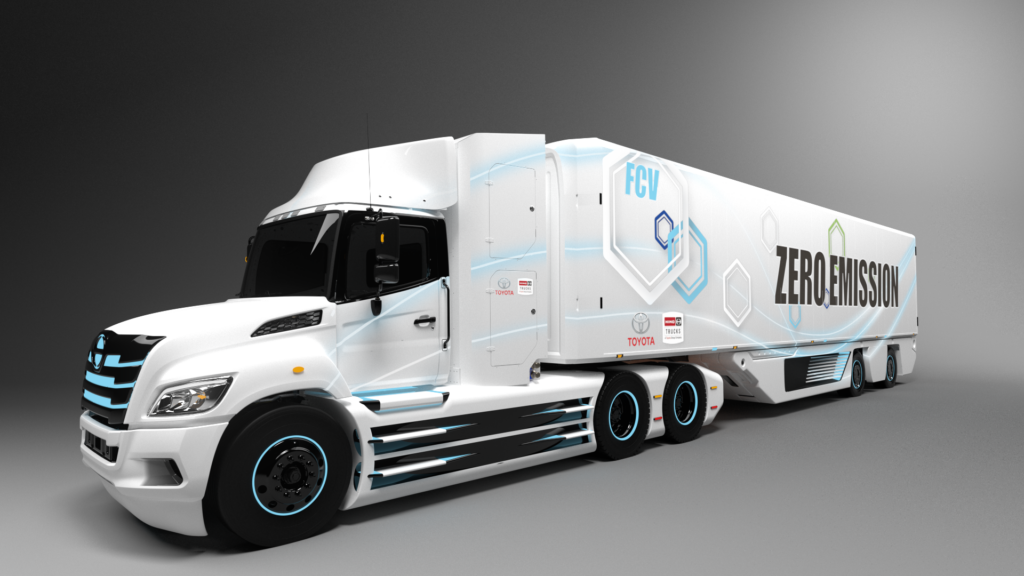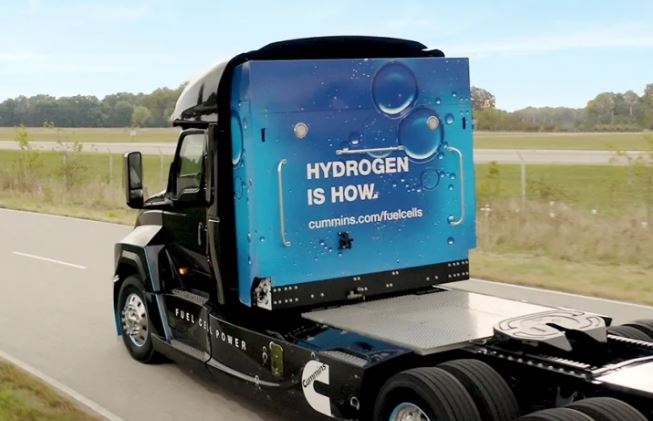Will battery- and fuel-cell-electric trucks both find a home?
Until someone invents a flux capacitor or discovers dilithium crystals somewhere in our solar system, the transition away from fossil fuels will involve lithium-ion batteries and hydrogen fuel cells. These two energy sources are often positioned as competing technologies, but they will probably prove to be more complementary.
Each has strengths and weaknesses that make it somewhat better suited to certain applications than others.
This isn’t a replay of the VHS-Beta debate. It more like the Apple-Windows debate. Many interested parties, including Cummins and Volvo Trucks, seem to think there’s room for both hydrogen and batteries in heavy trucks.
Hydrogen is not a fuel in a traditional context. It’s an energy storage medium much like a battery. In the same way electric energy from a solar array or wind farm can be stored in a battery, some of the harvested energy can be used to power electrolyzers that split water molecules into hydrogen and oxygen. The hydrogen gas is compressed and stored. Compressed hydrogen can be trucked around in high-pressure cylinders or cooled and stored as a cryogenic liquid in a tanker.
Hydrogen critics point to the losses that occur when converting energy from one form to another. Accepted estimates put the windmill-to-wheel conversion efficiency for hydrogen at somewhere around 60%, meaning 40% of the harvested energy is consumed in the process. Meanwhile conversion losses associated with batteries in the windmill-to-wheel chain are typically less than 10%.
As a point of reference, even today’s best diesel engines are less than 50% efficient at turning the chemical energy in diesel fuel into kinetic energy to move trucks.

Pick your business case
A volt is a volt whether it comes from a hydrogen fuel cell or a lithium-ion battery. How that volt is produced makes no difference to the electric drive motors on commercial vehicles. It’s easy to cherry pick the pros and cons of each technology to suit an agenda, but at the end of the day, both batteries and fuel calls are viable, if for different reasons.
Batteries are heavy and expensive, though cost and weight are both constantly improving. They don’t respond well to discharging below 20% of their capacity. To reduce charging times, they are often charged to only 80% of their rated capacity, which compromises range. They also lose some storage capacity over time due to fast charging and repeated charge and discharge cycles, and they are subject to efficiency losses in low ambient temperatures. To illustrate the point, a battery designed for a 100-mile duty cycle would need about 200 miles of capacity to cover all anticipated operating conditions and natural degradation over its expected life.
That’s a bit like carrying around 1,000 liters of fuel from which you can draw only 600 liters.
“Care must be taken not to oversize the batteries as that could impact freight weight capacity, while being too conservative could adversely affect range,” cautions Rick Mihelic, director emerging technologies at the North American Council for Freight Efficiency (NACFE). “When thinking about range, you also need to consider regenerative braking opportunities on your proposed routes. In some cases, they can be as high as 50% of the total battery capacity, though that cannot always be accounted for when spec’ing a vehicle.”
There are also environmental consequences associated with mining raw materials and producing batteries. But batteries offer a relatively easy connection to a power source through an electric grid that, for the most part, already exists.
The holy grail in terms of hydrogen is an abundant supply of renewable “green” hydrogen produced from wind, solar, hydroelectric, or nuclear sources.
Producing hydrogen from renewable sources remains costly, but the price is dropping, and the technology and its deployment are still relatively new. Cummins is upscaling its hydrogen development, recognizing the need to replace much of the current “grey” hydrogen production with “blue” or “green” forms. (Blue hydrogen sequesters much of the carbon dioxide that comes with grey hydrogen, and stores it underground.) Alberta is a leader in blue hydrogen, thanks to abundant natural gas and work on carbon sequestration.
Almost all the hydrogen produced today is grey, which is generally produced through steam methane reforming, using significant amounts of power from natural gas.
“This produces over 830 million tons of CO2 a year, which equates to more emissions than all of Germany,” says Cummins chairman and CEO Tom Linebarger.
While only 1% of today’s hydrogen is green, Linebarger said the future lies with hydrogen produced by electrolyzers powered by renewable sources. Cummins already produces electrolyzers.
“The production of green hydrogen and the adoption of fuel cell technologies in markets that are served by fossil fuels today will be critical to lowering greenhouse gas emissions globally,” Linebarger says.

Hydrogen’s perceived advantage
Keeping in mind that we are in early days of battery and fuel cell technologies, hydrogen advocates tout lighter overall vehicle weight as the one of the top advantages of fuel cell systems over batteries. Lighter trucks mean sacrificing less payload for range, which make fuel cell trucks better candidates for longhaul operations.
Current experience with pre-production Class 8 battery-electric trucks suggests they are about 7,000 to 10,000 lb. heavier than diesel trucks. At least two fuel-cell truck producers, Nikola and Hyundai, have said fuel cell trucks with a range of 500 miles will have curb weights around 18,000 to 20,000 lb., making them competitive with diesels.
An analysis by NACFE and vehicle specification sheets from Hyundai suggests those estimates might have been a bit optimistic. In one report, NACFE said it expects fuel cell tractors to be
4,000-5,000 lb. heavier than comparable diesel units, but still somewhat lighter than battery-electric trucks.
That Guidance Report compares a diesel and fuel cell truck, using theoretical specifications compiled by Ballard Power Systems and matching the range of NACFE’s Run on Less Regional diesel demonstration fleet. The net result was a hydrogen vehicle that weighed 7,750 lb. more than a diesel.
When Hyundai announced last fall that it would bring fuel cell trucks to North America, published specifications showed a 36-tonne 4×2 tractor with a range of 250 miles (400 km) has a curb weight of 21,560 lb. That’s the battery range with just two axles — not the 500-mile range on a 6×2 platform North American carriers want in a longhaul truck.
“Purpose-built tractor designs may find further ways to optimize for weight, and technology improvements on fuel cells likely will improve efficiencies and allow smaller tank sizes over time,” NACFE says.
Cost, supply and policy
Daimler Truck and Volvo Trucks have also announced ambitious plans for fuel-cell-powered trucks in a program called cellcentric. The joint venture plans to build one of Europe’s largest production facilities for fuel-cell systems, with operations slated to begin in 2025.
“If we’re talking about having a decarbonized road transport system by 2050, when you consider that a commercial vehicle has a 10-year life span, then it means that from 2040 onwards we can only deliver fossil-free solutions to our customers,” says Volvo chief technology officer Lars Stenqvist.
He’s speaking from a global perspective. There is already significant interest in hydrogen fuel cells in Europe and China, with the latter way ahead of most of the world in transit bus and light-truck fuel cell rollouts. North America has yet to embrace hydrogen as a viable alternative fuel. Here, battery-electric trucks have gained significant traction with regulators and green-energy proponents, leaving hydrogen fuel cells looking like a bit of a novelty.
Canada appears to be taking hydrogen seriously, and has developed a hydrogen strategy. We’re rich in the feedstocks that produce hydrogen, namely hydroelectric power and natural gas.
According to Stenqvist, the amount of hydrogen produced in the world today needs to increase by five to seven times. Since almost all the hydrogen produced is grey, it will need to be scrubbed into blue hydrogen or replaced by green hydrogen. And of course, the final product has to be competitively priced. He believes it can be done.
“We definitely have a way to go, but if trucking was the only industry relying on hydrogen in the long run, then I would be much more concerned than I am today,” he says. “But many other industries are committing to hydrogen today and they need sources of cheap clean hydrogen, too.”
Have your say
This is a moderated forum. Comments will no longer be published unless they are accompanied by a first and last name and a verifiable email address. (Today's Trucking will not publish or share the email address.) Profane language and content deemed to be libelous, racist, or threatening in nature will not be published under any circumstances.
I’m surprised that no mention was made of the HICE (Hydrogen Internal Combustion Engine) option. ICE is a mature technology with infrastructure in place and can more easily replace gasoline and diesel powered engines, imo. Cummins seems to be committed to this as a viable option.
Excellent take, Jim. Way too many feel there is only one right answer and it’s a battle with only one victor. Similar to diesel vs. gasoline ICEs, there are tremendous advantages to each dependent upon the end-use need.
I fear the day when the joyful exuberance over battery powered vehicles, becomes a another struggle to power the already existing generation capabilities and we are left rationing and, possibly, going without, the electricity we need.
We can build all the grid and plug-in power stations we want, but it is analogous to building more pipelines and fuel terminals; without the generation (petro or electricity) capacity, it’s nothing but at wasted effort.
Great awakening article. We should take heed. Thanks.